A Sustainability Innovation Experiential Learning Model for Virtual Reality Chemistry Laboratory: An Empirical Study with PLS-SEM and IPMA
Abstract
1. Introduction
- (1)
- To design and develop a virtual reality chemistry laboratory simulation game.
- (2)
- To investigate the effects of cognitive load on academic achievement.
- (3)
- To investigate the effects of self-efficacy on learning motivation.
- (4)
- To investigate the effects of learning motivation on academic achievement.
2. Background
2.1. Virtual Reality in Science
2.2. Virtual Chemical Laboratory
3. Research Hypothesis
3.1. The Relationships among Experiential Learning, Learning Motivation, and Academic Achievement
3.2. The Relationship between Cognitive Load and Learning Motivation
3.3. The Relationship between Self-Efficacy and Learning Motivation
3.4. The Relationship between Learning Motivation and Academic Achievement
4. The VR Chemistry Laboratory Framework
4.1. Framework of System Design
4.2. System Interface
5. Research Methods
5.1. Research Model
5.2. Questionnaire
5.3. Participants and Procedure
6. Data Analysis
6.1. Descriptive Statistics
6.2. Measurement Models and Reliability and Validity Analysis
6.3. Evaluation of the Structural Model
6.4. Evaluation of the Collinearity
6.5. Path Coefficient of the Structural Model
6.5.1. Coefficient of Determination (R2)
6.5.2. f2 Effect Size
6.5.3. Predictive Relevance (Q2)
6.5.4. Global Goodness of Fit (GoF)
6.5.5. Important-Performance Matrix Analysis
6.5.6. The Validation of Students’ Academic Achievement
7. Discussion
7.1. The Relationships among Experiential Learning, Learning Motivation, and Academic Achievement
7.2. The Relationship between Cognitive and Motivation
7.3. The Relationship between Self-Efficacy and Learning Motivation
7.4. The Relationship between Learning Motivation and Academic Achievement
8. Conclusions
8.1. Theoretical Implications
8.2. Practical Implications
8.3. Limitations and Future Work
Author Contributions
Funding
Acknowledgments
Conflicts of Interest
References
- Maroušek, J. Use of continuous pressure shockwaves apparatus in rapeseed oil processing. Clean Technol. Environ. Policy 2013, 15, 721–725. [Google Scholar] [CrossRef]
- Mardoyan, A.; Braun, P. Analysis of Czech subsidies for solid biofuels. Int. J. Green Energy 2015, 12, 405–408. [Google Scholar] [CrossRef]
- Bieber, N.; Ker, J.H.; Wang, X.; Triantafyllidis, C.; van Dam, K.H.; Koppelaar, R.H.; Shah, N. Sustainable planning of the energy-water-food nexus using decision making tools. Energy Policy 2018, 113, 584–607. [Google Scholar] [CrossRef]
- Fazey, I.; Schäpke, N.; Caniglia, G.; Patterson, J.; Hultman, J.; Van Mierlo, B.; Säwe, F.; Wiek, A.; Wittmayer, J.; Aldunce, P.; et al. Ten essentials for action-oriented and second order energy transitions, transformations and climate change research. Energy Res. Soc. Sci. 2018, 40, 54–70. [Google Scholar] [CrossRef]
- Maroušek, J. Biotechnological partition of the grass silage to streamline its complex energy utilization. Int. J. Green Energy 2014, 11, 962–968. [Google Scholar] [CrossRef]
- Koytsoumpa, E.I.; Bergins, C.; Kakaras, E. The CO2 economy: Review of CO2 capture and reuse technologies. J. Supercrit. Fluids 2018, 132, 3–16. [Google Scholar] [CrossRef]
- Maroušek, J. Significant breakthrough in biochar cost reduction. Clean Technol. Environ. Policy 2014, 16, 1821–1825. [Google Scholar] [CrossRef]
- Robichaud, L.B.; Anantatmula, V.S. Greening project management practices for sustainable construction. J. Manag. Eng. 2010, 27, 48–57. [Google Scholar] [CrossRef]
- Jaca, C.; Prieto-Sandoval, V.; Psomas, E.L.; Ormazabal, M. What should consumer organizations do to drive environmental sustainability? J. Clean. Prod. 2018, 181, 201–208. [Google Scholar] [CrossRef]
- Thürer, M.; Tomašević, I.; Stevenson, M.; Qu, T.; Huisingh, D. A systematic review of the literature on integrating sustainability into engineering curricula. J. Clean. Prod. 2018, 181, 608–617. [Google Scholar] [CrossRef]
- Saunila, M.; Ukko, J.; Rantala, T. Sustainability as a driver of green innovation investment and exploitation. J. Clean. Prod. 2018, 179, 631–641. [Google Scholar] [CrossRef]
- Beumer, C.; Figge, L.; Elliott, J. The sustainability of globalisation: Including the ‘social robustness criterion’. J. Clean. Prod. 2018, 179, 704–715. [Google Scholar] [CrossRef]
- Tejedor, G.; Segalàs, J.; Rosas-Casals, M. Transdisciplinarity in higher education for sustainability: How discourses are approached in engineering education. J. Clean. Prod. 2018, 175, 29–37. [Google Scholar] [CrossRef]
- Brundiers, K.; Wiek, A. Do we teach what we preach? An international comparison of problem-and project-based learning courses in sustainability. Sustainability 2013, 5, 1725–1746. [Google Scholar] [CrossRef]
- Yilmaz, R.M.; Baydas, O.; Karakus, T.; Goktas, Y. An examination of interactions in a three-dimensional virtual world. Comput. Educ. 2015, 88, 256–267. [Google Scholar] [CrossRef]
- Ángel, S.-A. Real and virtual bioreactor laboratory sessions by STSE–CLIL WebQuest. Educ. Chem. Eng. 2015, 13, 1–8. [Google Scholar] [CrossRef]
- Martin-Villalba, C.; Urquia, A.; Dormido, S. Development of virtual-labs for education in chemical process control using Modelica. Comput. Chem. Eng. 2012, 39, 170–178. [Google Scholar] [CrossRef]
- Rafael, A.C.; Bernardo, F.; Ferreira, L.M.; Rasteiro, M.G.; Teixeira, J.C. Virtual applications using a web platform to teach chemical engineering: The distillation case. Educ. Chem. Eng. 2007, 2, 20–28. [Google Scholar] [CrossRef]
- Hammick, J.K.; Lee, M.J. Do shy people feel less communication apprehension online? The effects of virtual reality on the relationship between personality characteristics and communication outcomes. Comput. Hum. Behav. 2014, 33, 302–310. [Google Scholar] [CrossRef]
- Domingues, L.; Rocha, I.; Dourado, F.; Alves, M.; Ferreira, E.C. Virtual laboratories in (bio)chemical engineering education. Educ. Chem. Eng. 2010, 5, e22–e27. [Google Scholar] [CrossRef]
- Ragazzi, M.; Ghidini, F. Environmental sustainability of universities: Critical analysis of a green ranking. Energy Procedia 2017, 119, 111–120. [Google Scholar] [CrossRef]
- Holdsworth, S.; Thomas, I. A sustainability education academic development framework (SEAD). Environ. Educ. Res. 2016, 22, 1073–1097. [Google Scholar] [CrossRef]
- Annan-Diab, F.; Molinari, C. Interdisciplinarity: Practical approach to advancing education for sustainability and for the Sustainable Development Goals. Int. J. Manag. Educ. 2017, 15, 73–83. [Google Scholar] [CrossRef]
- Beynaghi, A.; Trencher, G.; Moztarzadeh, F.; Mozafari, M.; Maknoon, R.; Leal Filho, W. Future sustainability scenarios for universities: Moving beyond the United Nations Decade of Education for Sustainable Development. J. Clean. Prod. 2016, 112, 3464–3478. [Google Scholar] [CrossRef]
- Luederitz, C.; Schäpke, N.; Wiek, A.; Lang, D.J.; Bergmann, M.; Bos, J.J.; Burch, S.; Davies, A.; Evans, J.; König, A. Learning through evaluation—A tentative evaluative scheme for sustainability transition experiments. J. Clean. Prod. 2017, 169, 61–76. [Google Scholar] [CrossRef]
- Lee, E.A.L.; Wong, K.W.; Fung, C.C. How does desktop virtual reality enhance learning outcomes? A structural equation modeling approach. Comput. Educ. 2010, 55, 1424–1442. [Google Scholar]
- Pasqualotti, A.; Freitas, C.M.D.S. MAT3D: A virtual reality modeling language environment for the teaching and learning of mathematics. CyberPsychol. Behav. 2002, 5, 409–422. [Google Scholar] [CrossRef]
- Serrano, B.; Botella, C.; Baños, R.M.; Alcañiz, M. Using virtual reality and mood-induction procedures to test products with consumers of ceramic tiles. Comput. Hum. Behav. 2013, 29, 648–653. [Google Scholar] [CrossRef]
- Van Kerrebroeck, H.; Brengman, M.; Willems, K. Escaping the crowd: An experimental study on the impact of a Virtual Reality experience in a shopping mall. Comput. Hum. Behav. 2017, 77, 437–450. [Google Scholar] [CrossRef]
- Didehbani, N.; Allen, T.; Kandalaft, M.; Krawczyk, D.; Chapman, S. Virtual reality social cognition training for children with high functioning autism. Comput. Hum. Behav. 2016, 62, 703–711. [Google Scholar] [CrossRef]
- Burdea, G.C.; Coiffet, P. Virtual Reality Technology, 2nd ed.; John Wiley & Sons: New York, NY, USA, 2003. [Google Scholar]
- Peperkorn, H.M.; Diemer, J.; Mühlberger, A. Temporal dynamics in the relation between presence and fear in virtual reality. Comput. Hum. Behav. 2015, 48, 542–547. [Google Scholar] [CrossRef]
- Merchant, Z.; Goetz, E.T.; Cifuentes, L.; Keeney-Kennicutt, W.; Davis, T.J. Effectiveness of virtual reality-based instruction on students’ learning outcomes in K-12 and higher education: A meta-analysis. Comput. Educ. 2014, 70, 29–40. [Google Scholar] [CrossRef]
- Figueroa, P.; Bischof, W.F.; Boulanger, P.; Hoover, H.J.; Taylor, R. Intml: A dataflow oriented development system for virtual reality applications. Presence 2008, 17, 492–511. [Google Scholar] [CrossRef]
- Kartiko, I.; Kavakli, M.; Cheng, K. Learning science in a virtual reality application: The impacts of animated-virtual actors’ visual complexity. Comput. Educ. 2010, 55, 881–891. [Google Scholar] [CrossRef]
- Mikropoulos, T.A.; Natsis, A. Educational virtual environments: A ten-year review of empirical research (1999–2009). Comput. Educ. 2011, 56, 769–780. [Google Scholar] [CrossRef]
- Jou, M.; Wang, J. Investigation of effects of virtual reality environments on learning performance of technical skills. Comput. Hum. Behav. 2013, 29, 433–438. [Google Scholar] [CrossRef]
- Simon, S.C.; Greitemeyer, T. The impact of immersion on the perception of pornography: A virtual reality study. Comput. Hum. Behav. 2019, 93, 141–148. [Google Scholar] [CrossRef]
- Bertram, J.; Moskaliuk, J.; Cress, U. Virtual training: Making reality work? Comput. Hum. Behav. 2015, 43, 284–292. [Google Scholar] [CrossRef]
- Kim, D.; Ko, Y.J. The impact of virtual reality (VR) technology on sport spectators’ flow experience and satisfaction. Comput. Hum. Behav. 2019, 93, 346–356. [Google Scholar] [CrossRef]
- Serrano, B.; Baños, R.M.; Botella, C. Virtual reality and stimulation of touch and smell for inducing relaxation: A randomized controlled trial. Comput. Hum. Behav. 2016, 55, 1–8. [Google Scholar] [CrossRef]
- Rasteiro, M.G.; Ferreira, L.; Teixeira, J.; Bernardo, F.P.; Carvalho, M.G.; Ferreira, A.; Ferreira, R.Q.; Garcia, F.; Baptista, C.M.; Oliveira, N.; et al. LABVIRTUAL—A virtual platform to teach chemical processes. Educ. Chem. Eng. 2009, 4, e9–e19. [Google Scholar] [CrossRef]
- FeiselL, L.D.; Rosa, A.J. The Role of the Laboratory in Undergraduate Engineering Education. J. Eng. Educ. 2005, 94, 121–130. [Google Scholar] [CrossRef]
- Kolb, A.Y.; Kolb, D.A. Learning styles and learning spaces: Enhancing experiential learning in higher education. Acad. Manag. Learn. Educ. 2005, 4, 193–212. [Google Scholar] [CrossRef]
- Kolb, D. Experiential Learning: Experience as the Source of Learning and Development; FT Press: Upper Saddle River, NJ, USA, 1984. [Google Scholar]
- Keller, J.M. Development and Use of the ARCS Model of Motivational Design. J. Instr. Dev. 1987, 10, 2–10. [Google Scholar] [CrossRef]
- Di Serio, Á.; Ibáñez, M.B.; Kloos, C.D. Impact of an augmented reality system on students’ motivation for a visual art course. Comput. Educ. 2013, 68, 586–596. [Google Scholar] [CrossRef]
- Wu, W.H.; Yan, W.C.; Kao, H.Y.; Wang, W.Y.; Wu, Y.C.J. Integration of RPG use and ELC foundation to examine students’ learning for practice. Comput. Hum. Behav. 2016, 55, 1179–1184. [Google Scholar] [CrossRef]
- Shokoohi, H.; Boniface, K.; Kaviany, P.; Armstrong, P.; Calabrese, K.; Pourmand, A. An Experiential Learning Model Facilitates Learning of Bedside Ultrasound by Preclinical Medical Students. J. Surg. Educ. 2016, 73, 208–214. [Google Scholar] [CrossRef] [PubMed]
- Reedy, G.B. Using Cognitive Load Theory to Inform Simulation Design and Practice. Clin. Simul. Nurs. 2015, 11, 355–360. [Google Scholar] [CrossRef]
- Skulmowski, A.; Pradel, S.; Kühnert, T.; Brunnett, G.; Rey, G.D. Embodied learning using a tangible user interface: The effects of haptic perception and selective pointing on a spatial learning task. Comput. Educ. 2015, 92–93, 64–75. [Google Scholar] [CrossRef]
- Dang, T.-D.; Chen, G.-D.; Dang, G.; Li, L.-Y.; Nurkhamid. RoLo: A dictionary interface that minimizes extraneous cognitive load of lookup and supports incidental and incremental learning of vocabulary. Comput. Educ. 2012, 61, 251–260. [Google Scholar] [CrossRef]
- Pastore, R. The effects of time-compressed instruction and redundancy on learning and learners’ perceptions of cognitive load. Comput. Educ. 2012, 58, 641–651. [Google Scholar] [CrossRef]
- Broadbent, J.; Poon, W.L. Self-regulated learning strategies & academic achievement in online higher education learning environments: A systematic review. Internet High. Educ. 2015, 27, 1–13. [Google Scholar] [CrossRef]
- Choi, K.H.; Kim, D.-Y. A cross cultural study of antecedents on career preparation behavior: Learning motivation, academic achievement, and career decision self-efficacy. J. Hosp. Leisure Sport Tour. Educ. 2013, 13, 19–32. [Google Scholar] [CrossRef]
- Chowa, G.A.N.; Masa, R.D.; Ramos, Y.; Ansong, D. How do student and school characteristics influence youth academic achievement in Ghana? A hierarchical linear modeling of Ghana YouthSave baseline data. Int. J. Educ. Dev. 2015, 45, 129–140. [Google Scholar] [CrossRef]
- Sardegna, V.G.; Lee, J.; Kusey, C. Development and validation of the learner attitudes and motivations for pronunciation (LAMP) inventory. System 2014, 47, 162–175. [Google Scholar] [CrossRef]
- Haddad, S.I.; Taleb, R.A. The impact of self-efficacy on performance (An empirical study on business faculty members in Jordanian universities). Comput. Hum. Behav. 2016, 55, 877–887. [Google Scholar] [CrossRef]
- Gam, J.; Kim, G.; Jeon, Y. Influences of art therapists’ self-efficacy and stress coping strategieson burnout. Arts Psychother. 2016, 47, 1–8. [Google Scholar] [CrossRef]
- Hsia, L.-H.; Huang, I.; Hwang, G.-J. Effects of different online peer-feedback approaches on students’ performance skills, motivation and self-efficacy in a dance course. Comput. Educ. 2016, 96, 55–71. [Google Scholar] [CrossRef]
- Skaalvik, E.M.; Federici, R.A.; Klassen, R.M. Mathematics achievement and self-efficacy: Relations with motivation for mathematics. Int. J. Educ. Res. 2015, 72, 129–136. [Google Scholar] [CrossRef]
- Taylor, G.; Jungert, T.; Mageau, G.A.; Schattke, K.; Dedic, H.; Rosenfield, S.; Koestner, R. A self-determination theory approach to predicting school achievement over time: The unique role of intrinsic motivation. Contemp. Educ. Psychol. 2014, 39, 342–358. [Google Scholar] [CrossRef]
- Garris, R.; Ahlers, R.; Driskell, J.E. Games, motivation, and learning: A research and practice model. Simul. Gaming 2002, 33, 441–467. [Google Scholar] [CrossRef]
- Paas, F.; Tuovinen, J.E.; Tabbers, H.; Van Gerven, P.W. Cognitive load measurement as a means to advance cognitive load theory. Educ. Psychol. 2003, 38, 63–71. [Google Scholar] [CrossRef]
- Zhang, J.X.; Schwarzer, R. Measuring optimistic self-beliefs: A Chinese adaptation of the General Self-Efficacy Scale. Psychologia 1995, 38, 174–181. [Google Scholar]
- Pintrich, P.R.; Schrauben, B. Students’ motivational beliefs and their cognitive engagement in classroom academic tasks. In Student Perceptions in the Classroom; Lawrence Erlbaum Associates, Inc.: Hillsdale, NJ, USA, 1992; pp. 149–183. [Google Scholar]
- Peterson, E.R.; Brown, G.T.; Irving, S.E. Secondary school students’ conceptions of learning and their relationship to achievement. Learn. Individ. Differ. 2010, 20, 167–176. [Google Scholar] [CrossRef]
- Fornell, C.; Larcker, D.F. Evaluating Structural Equation Models with Unobservable Variables and Measurement Error. J. Mark. Res. 1981, 18, 39–50. [Google Scholar] [CrossRef]
- Guilford, J.P.; Fruchter, B. Fundamental Statistics in Psychology and Education; McGraw-Hill: New York, NY, USA, 1978. [Google Scholar]
- Hair, J.F.; Ringle, C.M.; Sarstedt, M. PLS-SEM: Indeed a Silver Bullet. J. Mark. Theory Pract. 2011, 19, 139–152. [Google Scholar] [CrossRef]
- Cohen, J. Statistical power analysis. Curr. Dir. Psychol. Sci. 1992, 1, 98–101. [Google Scholar] [CrossRef]
- Tenenhaus, M.; Vinzi, V.E.; Chatelin, Y.-M.; Lauro, C. PLS path modeling. Comput. Stat. Data Anal. 2005, 48, 159–205. [Google Scholar] [CrossRef]
- Wetzels, M.; Odekerken-Schrder, G.; Oppen, C. Using PLS path modeling for assessing hierarchial construct models: Guidelines and impirical illustration. MIS Q. 2009, 33, 177–195. [Google Scholar] [CrossRef]
- Slack, N. The importance-performance matrix as a determinant of improvement priority. Int. J. Oper. Prod. Manag. 1994, 14, 59–75. [Google Scholar] [CrossRef]
- Hock, C.; Ringle, C.M.; Sarstedt, M. Management of multi-purpose stadiums: Importance and performance measurement of service interfaces. Int. J. Serv. Technol. Manag. 2010, 14, 188–207. [Google Scholar] [CrossRef]
- Josephsen, J. Cognitive Load Theory and Nursing Simulation: An Integrative Review. Clin. Simul. Nurs. 2015, 11, 259–267. [Google Scholar] [CrossRef]
- Khalaila, R. The relationship between academic self-concept, intrinsic motivation, test anxiety, and academic achievement among nursing students: Mediating and moderating effects. Nurse Educ. Today 2015, 35, 432–438. [Google Scholar] [CrossRef] [PubMed]
- Lemos, M.S.; Veríssimo, L. The Relationships between Intrinsic Motivation, Extrinsic Motivation, and Achievement, Along Elementary School. Procedia 2014, 112, 930–938. [Google Scholar] [CrossRef]
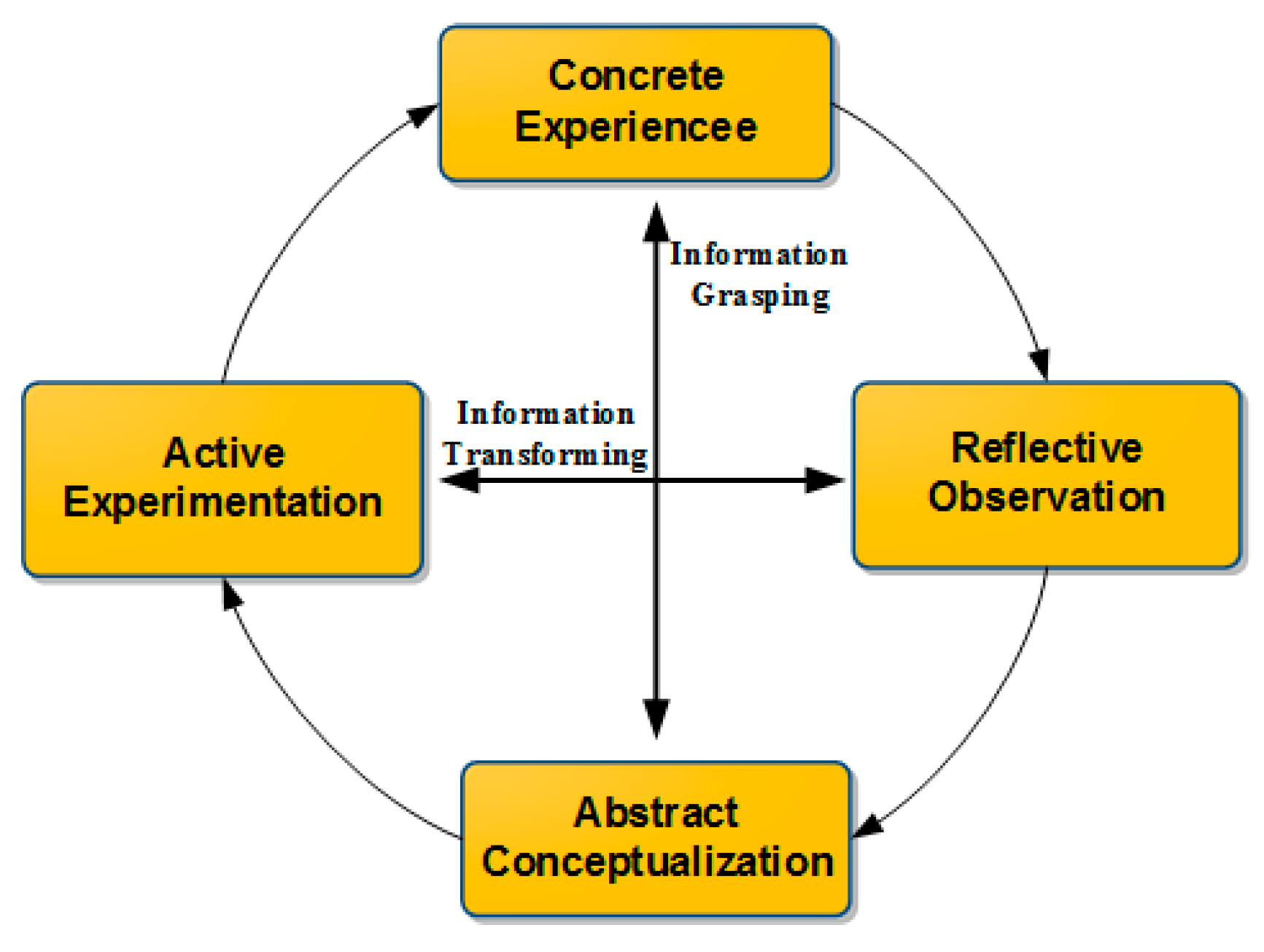
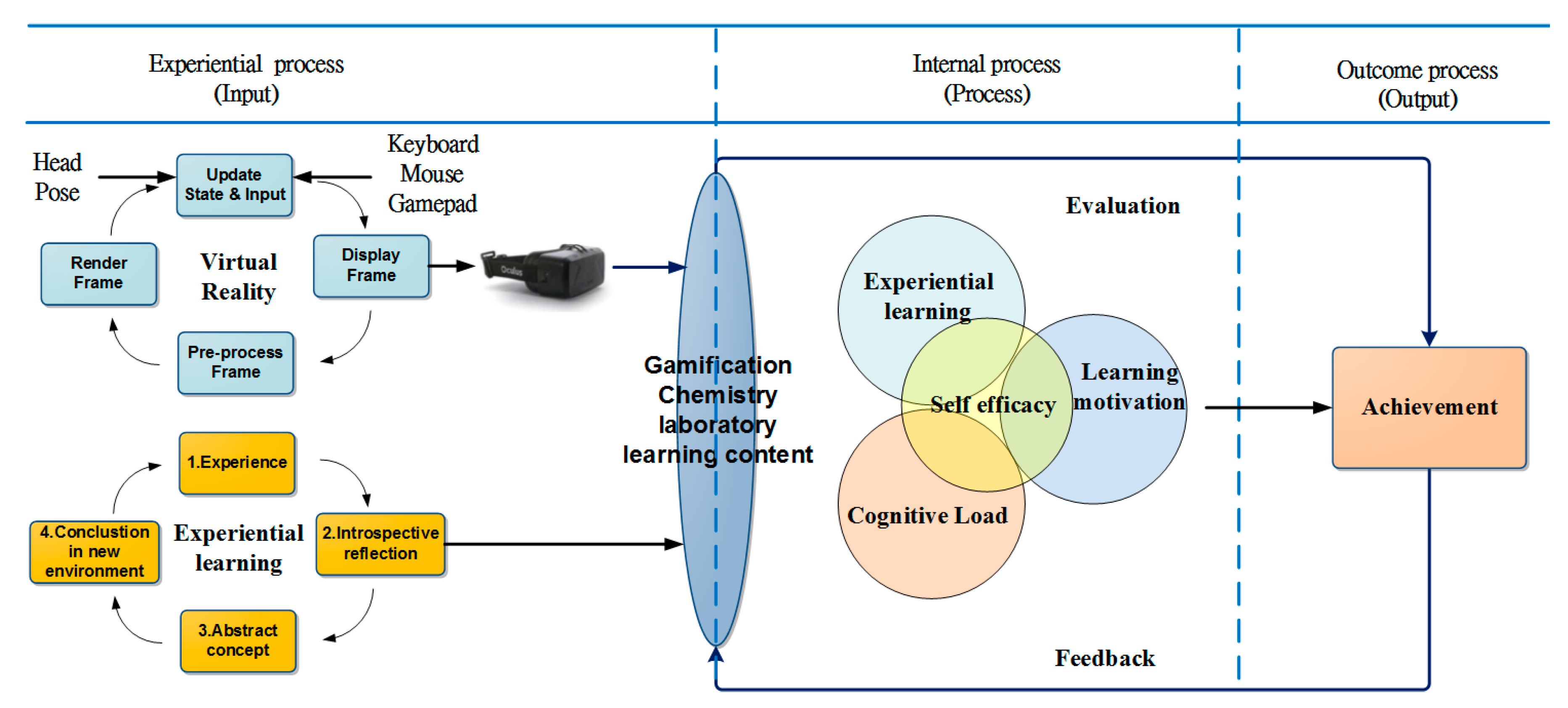
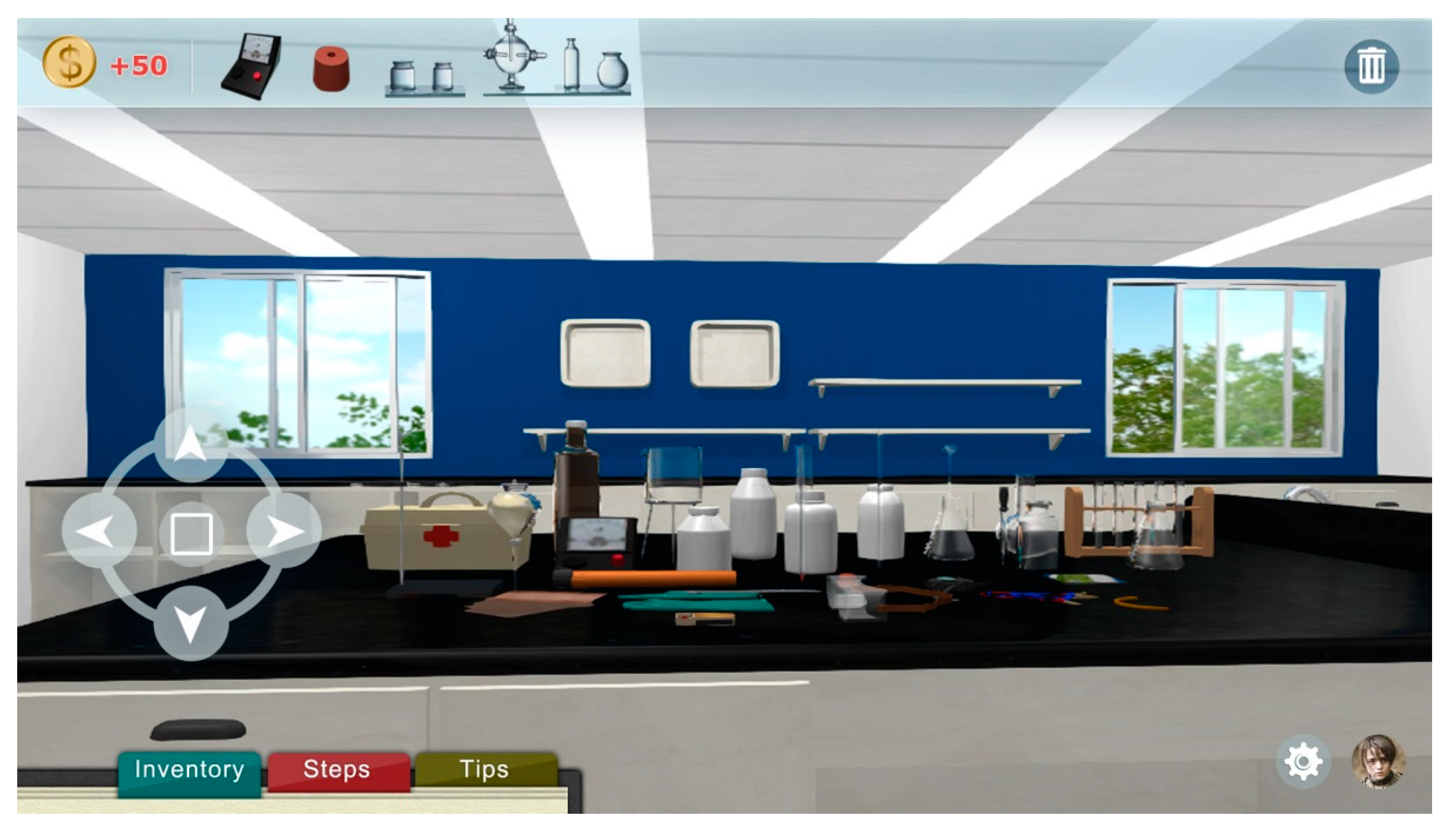
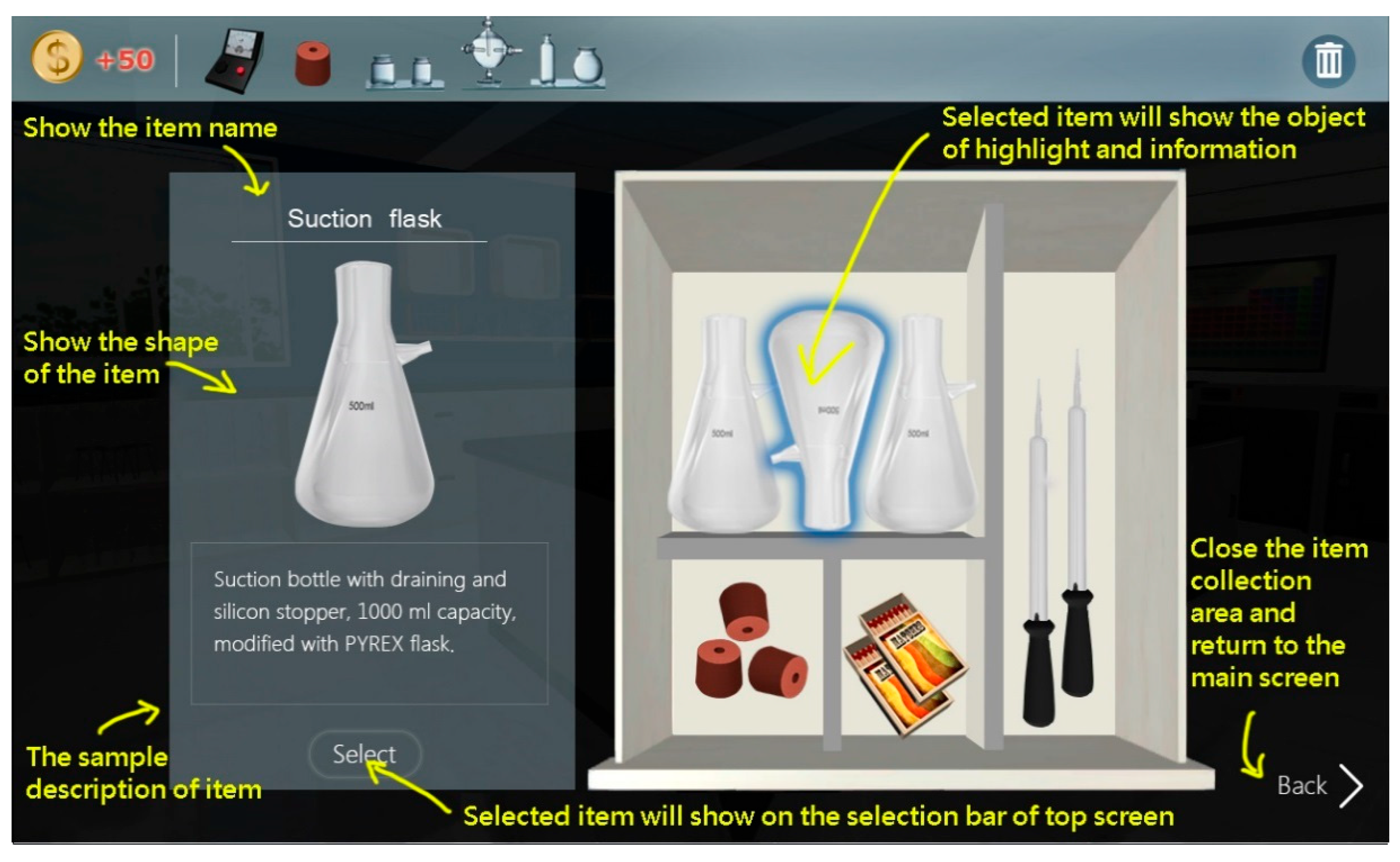
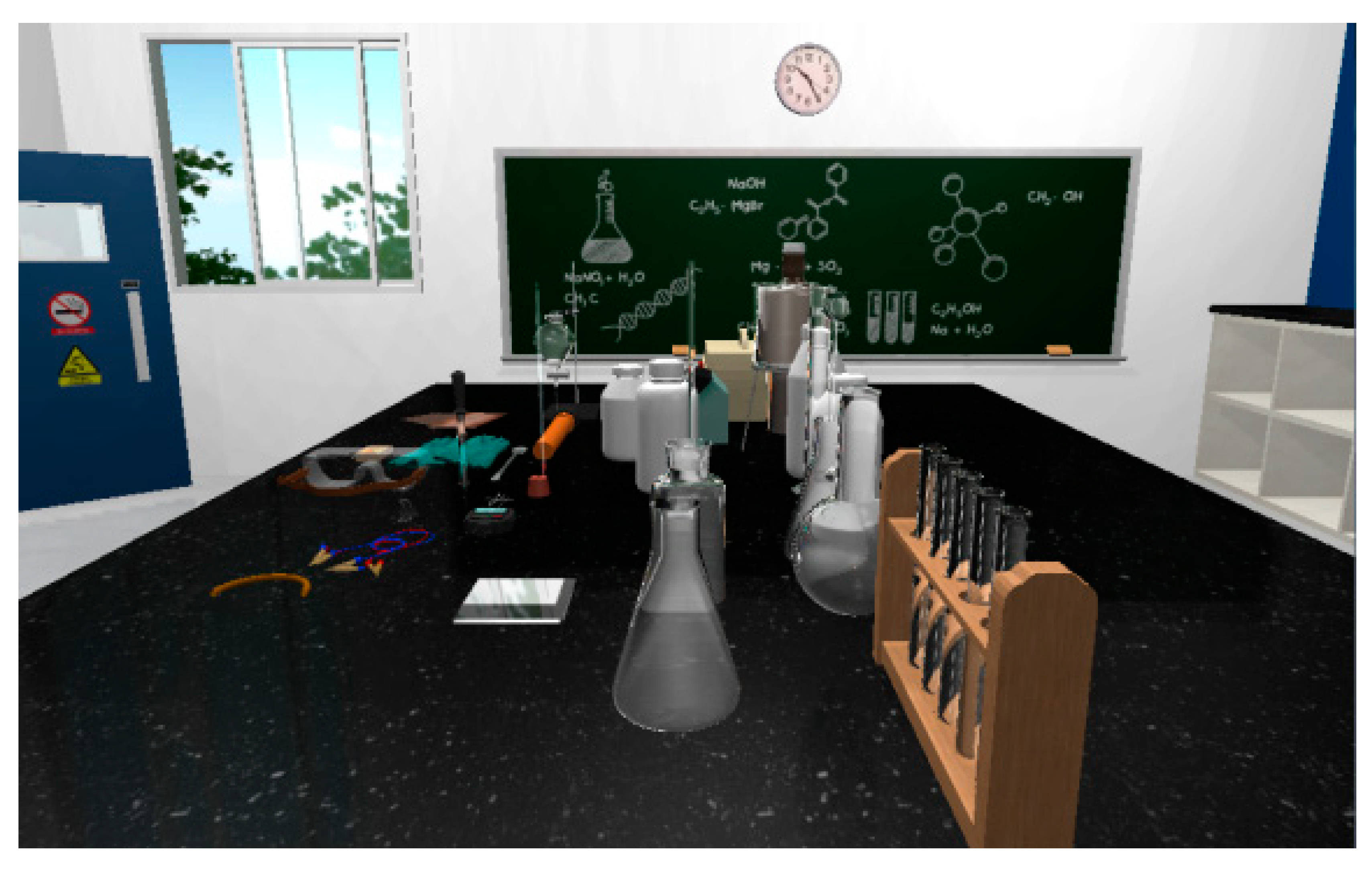
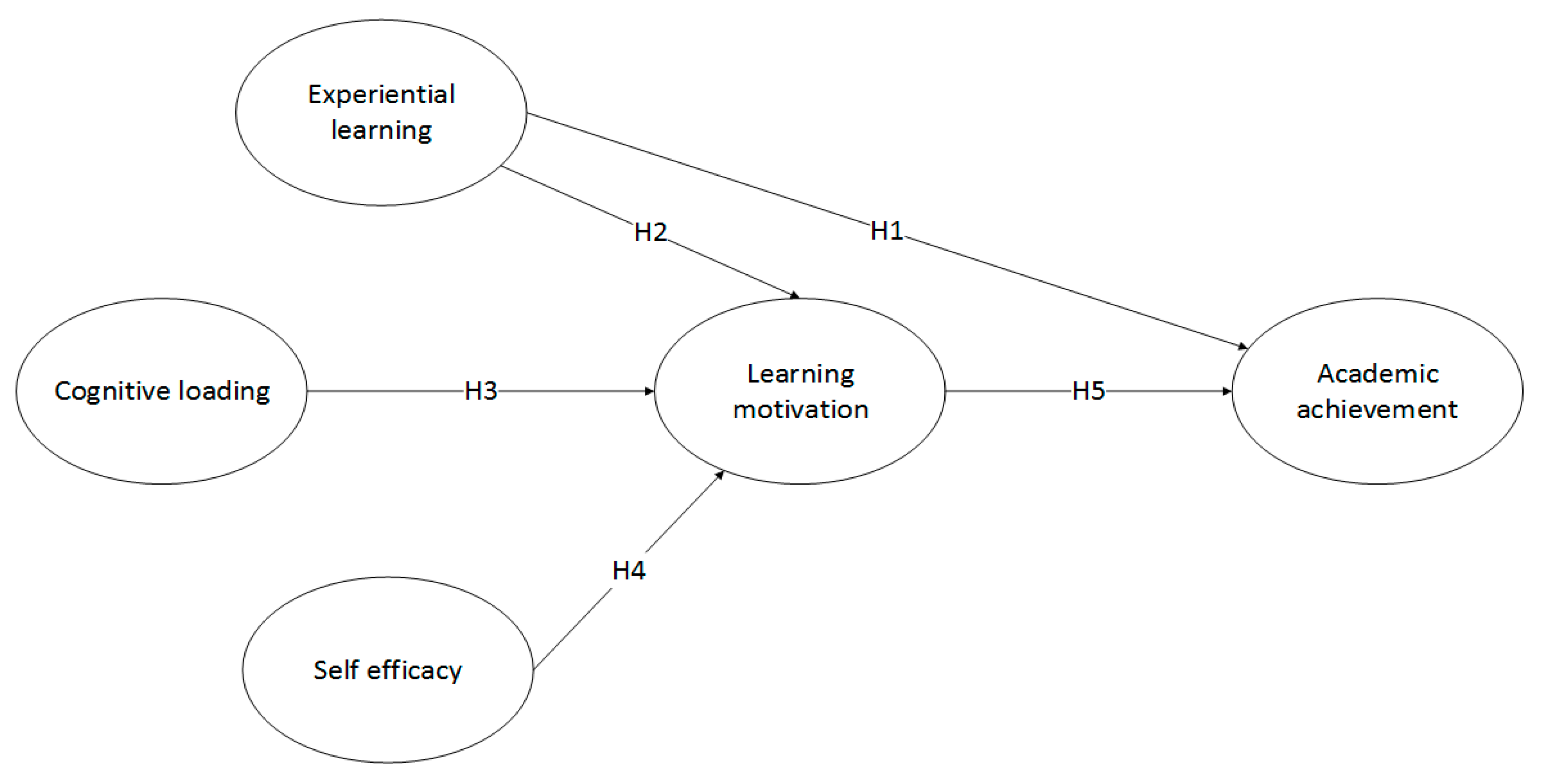

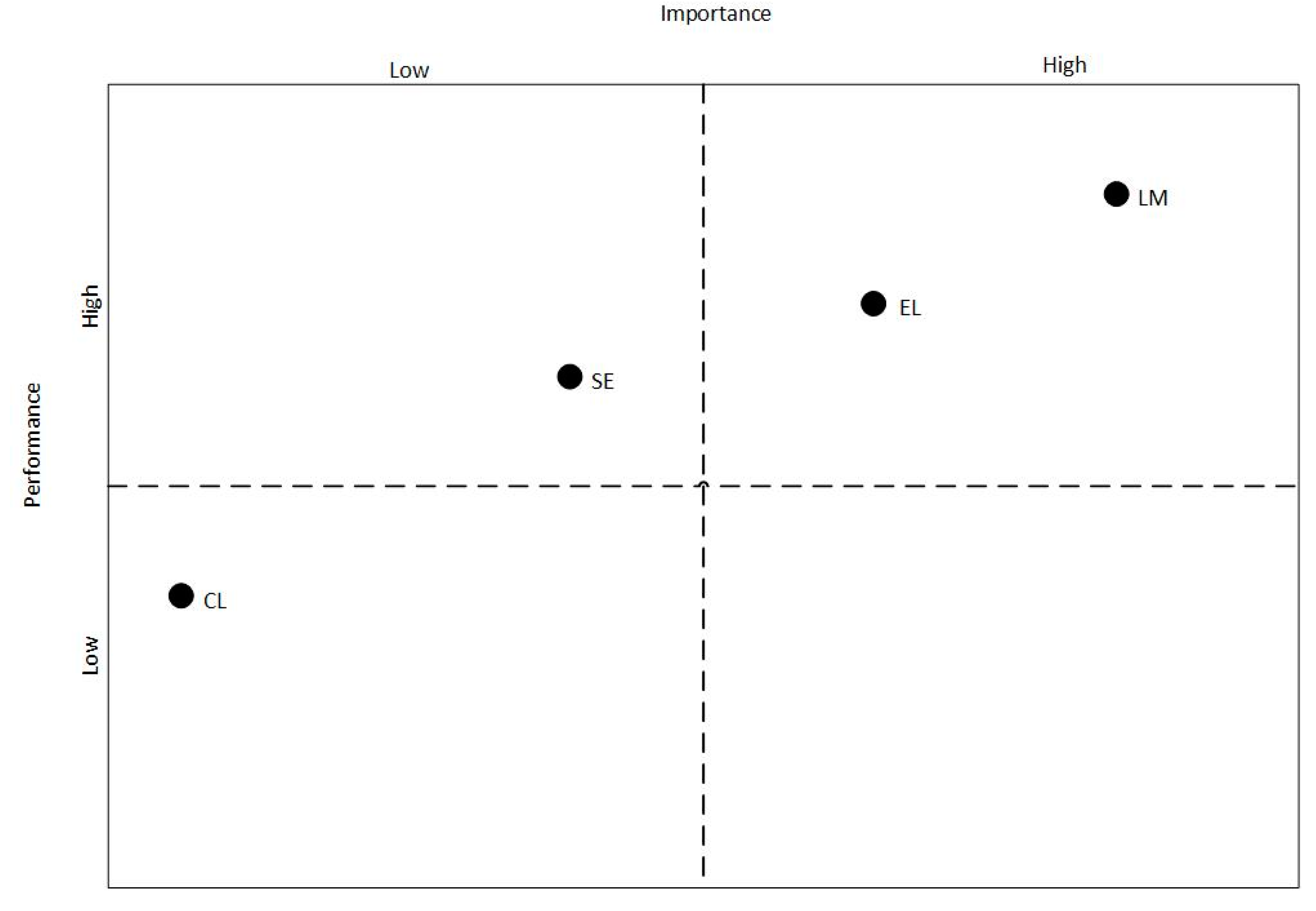
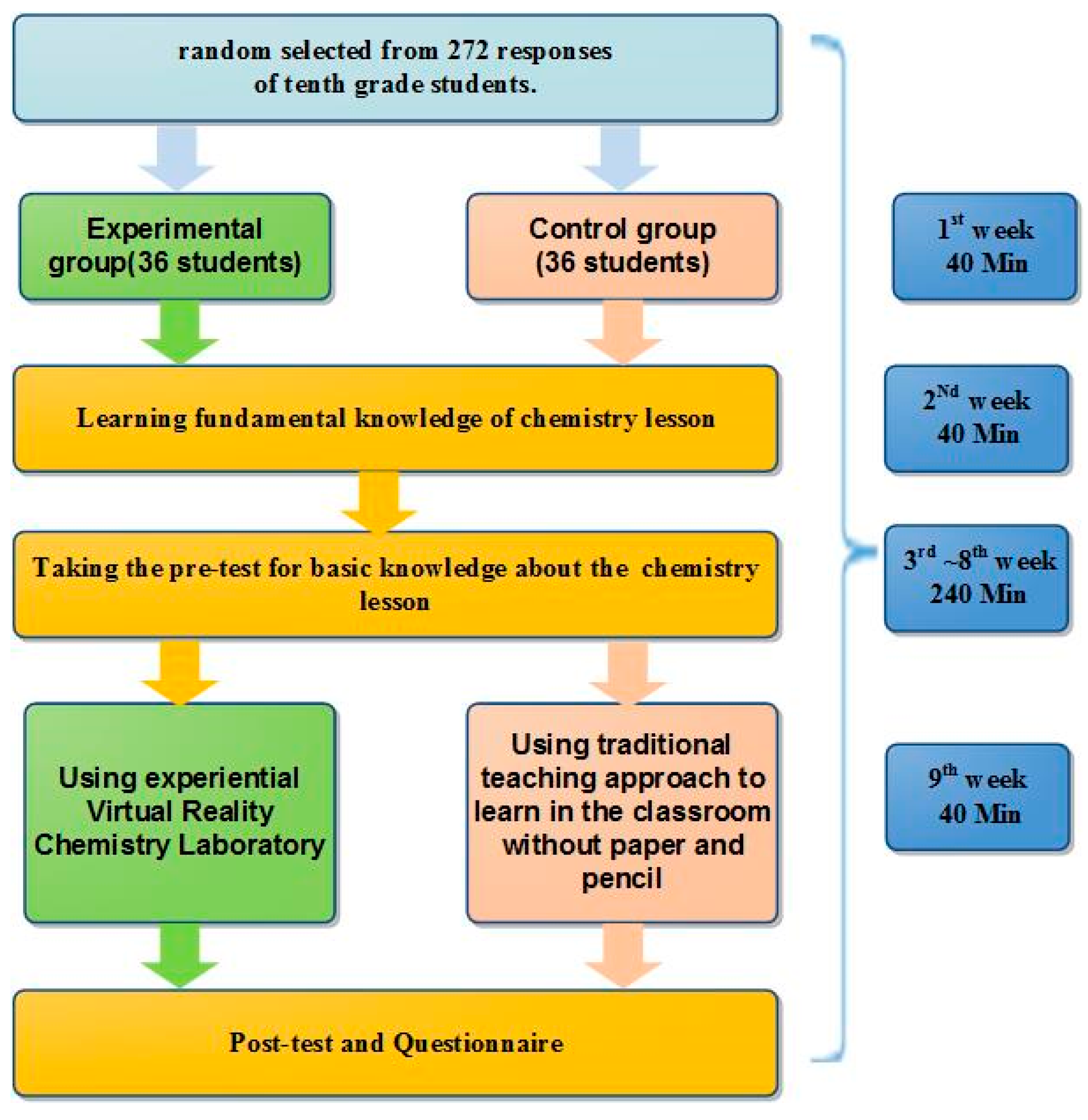
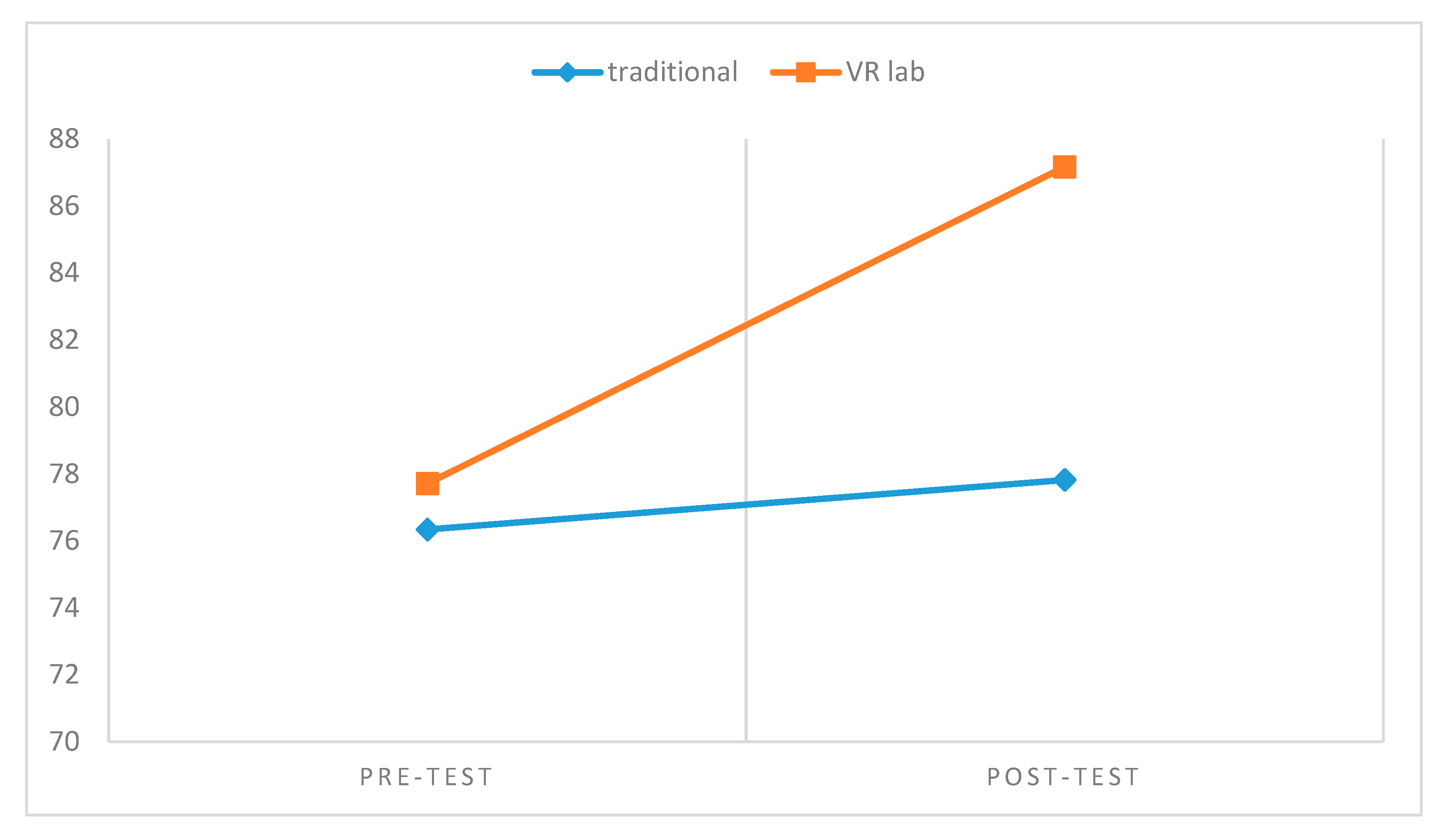
| Field | Describing the Research | Conclusion | Researchers |
|---|---|---|---|
| Human-Computers Studies | A dataflow oriented development system for virtual reality applications | The simple matching system was developed in four versions on a virtual reality platform. The studies show how users interact with various versions. | [34] |
| Computers & Education | Learning science in a virtual reality application: The impacts of animated-virtual actors’ visual complexity | There are positive correlations among presence, perceived emotion quality and learning perspective. There are no positive correlations with perceived difficulties, retention, or transfer. | [35] |
| Computers & Education | Educational virtual environments: A ten-year review of empirical research (1999–2009) | Collaboration and social negotiations are not only limited to participation in educational virtual environments, but also exist between participants and avatars, which provides a new dimension in computer assisted learning. | [36] |
| Human in Behaviors | Investigation of effects of virtual reality environments on learning performance of technical skills | Six modules: students prefer the simulation process and practical exercise among the six modules. | [37,38] |
| Computers & Education | Effectiveness of virtual reality-based instruction on students’ learning outcomes in K-12 and higher education: A meta-analysis | Mentioned that, in designing virtual reality instructions, the principles of instructional design should be considered. | [33] |
| Human in Behaviors | This study applied a virtual training environment to train police personnel for complex collaborative tasks. | In real and complex situations, through the measurement of learning transformation, virtual training is a good standard of training. | [39,40] |
| Human in Behaviors | Virtual reality and stimulation of touch and smell for inducing relaxation: A randomized controlled trial | When using a virtual reality environment, the sense of touch can improve efficacy because it provides more sensory information. | [41] |
| Experiential Learning | The Chemical Experiment | The Level of Game Design | Learning Indicators |
|---|---|---|---|
| 1. concrete experience abilities | Experimental safety explanation | 1. Experimental safety explanation level | 1. Obtain the analysis of argument through the experimental results |
| 2. reflective observation abilities | Experimental procedures | 2. experimental level | 2. Observe their meaning and concept formation through the changes |
| 3. abstract conceptualization abilities | Principles explanation | 3. test level | 3. Using scientific terms, symbols, and common expressions correctly |
| 4. active experimentation abilities | 4. Understanding the changes through the collection of gases. |
| Dimension | Item | References |
|---|---|---|
| Experiential learning (EL) | When I study, I don’t like the actual operation. | [44] |
| I learn though actual operation. | ||
| When I learn best, it is through implementation and practicing. | ||
| When I learn, I like to see the results of the implementation. | ||
| When I am learning, I always try to do something by myself. | ||
| Cognitive load (CL) | Compared with other students, I spent a lot of effort on performance in the virtual chemistry laboratory. | [64] |
| I cannot concentrate on learning about performance in the virtual chemistry laboratory in the future. | ||
| It causes me a lot of pressure on the performance in the virtual chemistry laboratory now. | ||
| Self-efficacy (SE) | If I do my best, I can always solve the problem. | [65] |
| Facing a chemical problem, I usually can find the solution. | ||
| If I make the necessary efforts, I will be able to solve most of the learning problems. | ||
| I can face problems calmly because I believe in my problem-solving ability. | ||
| When I get into trouble, I usually can get the solution. | ||
| Learning motivation (LM) | The beginning of the virtual chemistry laboratory attracts me. | [46,66] |
| For me, the most satisfying thing in the virtual chemistry laboratory is trying my best to understand the course. | ||
| I am really interested in the content of the virtual chemistry laboratory. | ||
| When I learn through using the virtual chemistry, I am confident that I can understand the chemical experiment. | ||
| I enjoy the chemical experiments in the virtual chemistry laboratory, so I want to understand more about chemical experiments. | ||
| If I can, I want to get better grades than most of the students in this class. | ||
| Academic achievement (AA) | When I really understand, I know what I have really learned. | [67] |
| When I can explain things to others, I know what I have learned. | ||
| Learning makes me more independent and more confident. | ||
| I learn a lot through participating in many different contents in the virtual chemistry laboratory. | ||
| Learning is being taught something I didn’t know before. |
| Construct | Mean | STD | Outer Loadings | Cronbach’s | CR | AVE | Fornell-Larcker Criterion | ||||
|---|---|---|---|---|---|---|---|---|---|---|---|
| Alpha | EL | CL | SE | LM | AA | ||||||
| EL | 5.93 | 0.96 | 0.81 | 0.87 | 0.91 | 0.66 | 0.81 | ||||
| CL | 5.72 | 1.23 | 0.85 | 0.8 | 0.88 | 0.71 | −0.58 | 0.84 | |||
| SE | 5.91 | 0.98 | 0.82 | 0.87 | 0.9 | 0.66 | 0.77 | −0.54 | 0.81 | ||
| LM | 5.97 | 0.95 | 0.83 | 0.88 | 0.91 | 0.68 | 0.73 | −0.58 | 0.72 | 0.82 | |
| AA | 5.29 | 1.06 | 0.79 | 0.85 | 0.91 | 0.63 | 0.7 | −0.6 | 0.66 | 0.81 | 0.8 |
| Items | EL | CL | SE | LM | AA | VIF |
|---|---|---|---|---|---|---|
| EL_1 | 0.82 | −0.48 | 0.71 | 0.65 | 0.63 | 2.14 |
| EL_2 | 0.84 | −0.49 | 0.60 | 0.54 | 0.54 | 2.28 |
| EL_3 | 0.84 | −0.43 | 0.70 | 0.68 | 0.61 | 2.21 |
| EL_4 | 0.81 | −0.47 | 0.55 | 0.56 | 0.57 | 2.07 |
| EL_5 | 0.76 | −0.49 | 0.52 | 0.49 | 0.47 | 2.04 |
| CL_1 | −0.52 | 0.85 | −0.45 | −0.49 | −0.48 | 1.82 |
| CL_2 | −0.47 | 0.86 | −0.47 | −0.48 | −0.51 | 1.93 |
| CL_3 | −0.48 | 0.82 | −0.45 | −0.49 | −0.54 | 1.54 |
| SE_1 | 0.54 | −0.37 | 0.82 | 0.50 | 0.49 | 2.33 |
| SE_2 | 0.61 | −0.42 | 0.78 | 0.60 | 0.55 | 1.71 |
| SE_3 | 0.66 | −0.47 | 0.82 | 0.59 | 0.52 | 2.22 |
| SE_4 | 0.64 | −0.44 | 0.82 | 0.58 | 0.56 | 2.04 |
| SE_5 | 0.64 | −0.47 | 0.82 | 0.61 | 0.54 | 1.99 |
| LM_1 | 0.59 | −0.49 | 0.62 | 0.81 | 0.67 | 2.02 |
| LM_2 | 0.53 | −0.41 | 0.53 | 0.81 | 0.62 | 2.34 |
| LM_3 | 0.61 | −0.52 | 0.62 | 0.87 | 0.69 | 2.62 |
| LM_4 | 0.67 | −0.55 | 0.61 | 0.84 | 0.68 | 2.30 |
| LM_5 | 0.58 | −0.42 | 0.56 | 0.79 | 0.69 | 2.03 |
| AA_1 | 0.62 | −0.54 | 0.66 | 0.70 | 0.80 | 1.78 |
| AA_2 | 0.59 | −0.50 | 0.52 | 0.69 | 0.86 | 2.49 |
| AA_3 | 0.58 | −0.50 | 0.52 | 0.69 | 0.86 | 2.50 |
| AA_4 | 0.48 | −0.44 | 0.45 | 0.89 | 0.74 | 1.58 |
| AA_5 | 0.50 | −0.40 | 0.46 | 0.55 | 0.72 | 1.57 |
| Construct | R2 | f2 (LM) | f2 (AA) | q2 (LM) | q2 (AA) |
|---|---|---|---|---|---|
| EL | 0.121 | 0.079 | 0.061 | ||
| CL | 0.059 | 0.027 | |||
| SE | 0.115 | 0.054 | |||
| LM | 0.612 | 0.489 | 0.028 | ||
| AA | 0.684 | 0.217 |
| AA | Important | Performance | ||
|---|---|---|---|---|
| Direct | Indirect | Total Effect | ||
| EL | 0.23 | 0.23 | 0.43 | 82.46 |
| CL | −0.12 | −0.12 | 21.15 | |
| SE | 0.22 | 0.22 | 82.12 | |
| LM | 0.64 | 0.64 | 83.04 | |
| Group | N | Mean | SD | SE | F | Sig. | |
|---|---|---|---|---|---|---|---|
| pretest | Control | 36 | 76.34 | 7.52 | 1.27 | 0.635 | 0.428 |
| Experimental | 36 | 77.71 | 6.86 | 1.16 | |||
| posttest | Control | 36 | 77.82 | 7.82 | 1.32 | 26.086 | 0.000 |
| Experimental | 36 | 87.17 | 7.47 | 1.26 |
© 2019 by the authors. Licensee MDPI, Basel, Switzerland. This article is an open access article distributed under the terms and conditions of the Creative Commons Attribution (CC BY) license (http://creativecommons.org/licenses/by/4.0/).
Share and Cite
Su, C.-H.; Cheng, T.-W. A Sustainability Innovation Experiential Learning Model for Virtual Reality Chemistry Laboratory: An Empirical Study with PLS-SEM and IPMA. Sustainability 2019, 11, 1027. https://doi.org/10.3390/su11041027
Su C-H, Cheng T-W. A Sustainability Innovation Experiential Learning Model for Virtual Reality Chemistry Laboratory: An Empirical Study with PLS-SEM and IPMA. Sustainability. 2019; 11(4):1027. https://doi.org/10.3390/su11041027
Chicago/Turabian StyleSu, Chung-Ho, and Ting-Wen Cheng. 2019. "A Sustainability Innovation Experiential Learning Model for Virtual Reality Chemistry Laboratory: An Empirical Study with PLS-SEM and IPMA" Sustainability 11, no. 4: 1027. https://doi.org/10.3390/su11041027
APA StyleSu, C.-H., & Cheng, T.-W. (2019). A Sustainability Innovation Experiential Learning Model for Virtual Reality Chemistry Laboratory: An Empirical Study with PLS-SEM and IPMA. Sustainability, 11(4), 1027. https://doi.org/10.3390/su11041027






